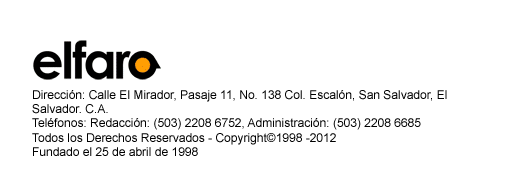ARENA'S SAN SALVADOR MAYORAL CANDIDATE LEADS
Publicado el 8 de Septiembre de 2011
id: 43855
date: 10/27/2005 19:38
refid: 05SANSALVADOR2929
origin: Embassy San Salvador
classification: CONFIDENTIAL
destination: 05SANSALVADOR843
header:
This record is a partial extract of the original cable. The full text of the original cable is not available.
----------------- header ends ----------------
C O N F I D E N T I A L SAN SALVADOR 002929
SIPDIS
E.O. 12958: DECL: 10/26/2015
TAGS: ES, PGOV, PREL, ELECTIONS 2006
SUBJECT: ARENA'S SAN SALVADOR MAYORAL CANDIDATE LEADS
REF: A. SAN SALVADOR 843
B. SAN SALVADOR 1823
Classified By: DCM Michael A. Butler, Reason 1.4 (d)
1. (C) SUMMARY: With little more than four months to go
until the March 2006 municipal and Legislative Assembly
elections, the Nationalist Republican Alliance (ARENA) party
is making a serious effort at regaining the San Salvador
mayoralty, held by the left for nearly a decade. A San
Salvador leading daily's October poll showed an almost
two-to-one inclination among respondents to vote for ARENA,
rather than the Farabundo Marti National Liberation Front
(FMLN). However, name recognition of both parties' mayoral
candidates is low among voters, and ARENA's weak candidate
will have an uphill battle wresting control of the FMLN's
metropolitan stronghold. There is a very strong possibility
that the Christian Democratic Party (PDC), other minor left
parties, and the Revolutionary Democratic Front (FDR) will
run a strong coalition candidate in San Salvador, which will
likely split the leftist vote, thus working to ARENA's
advantage. Since the undecided vote is close to 50 percent
at this point, it is quite too early to determine whether the
ARENA candidate will be able to maintain his present lead.
END SUMMARY.
2. (SBU) A poll publicized October 26 by San Salvador
leading daily La Prensa Grafica showed that 32.8 percent of
voters favor ARENA to run the San Salvador city hall,
compared with 18.0 percent for the FMLN; 33.7 percent of the
500 subjects interviewed either offered no response, or
declined to reveal their preference. ARENA has not held San
Salvador city hall since a leftist coalition of the FMLN,
Democratic Convergence (CD), and Unity Movement (MU) carried
Hector Silva to victory in 1997 over ARENA. Silva ran as the
FMLN's candidate in 2000 and won reelection handily by 17
percent of the vote. In 2002, Silva decided not to pursue
reelection in 2003, opting instead to head a commission on
healthcare reform in the wake of the nation's bitter ISSS
(public healthcare system) strike; differences in views
regarding the ISSS crisis soon led to his departure from the
FMLN. Elected in 2003, incumbent FMLN San Salvador Mayor
Carlos Rivas Zamora ran afoul of party hardliners controlled
by Schafik Handal, and has since resigned from the party (see
ref. A). Handal picked orthodox ally Violeta Menjivar to be
the Front's 2006 candidate, but, notwithstanding recent
intensive political training in Cuba, Menjivar displays
little charisma, warmth, or political savvy, and remains
unknown to approximately half of prospective San Salvador
voters, as does her ARENA opponent Rodrigo Samayo.
3. (SBU) A loose center-left coalition that will apparently
include moderate FMLN defectors' new Revolutionary Democratic
Front (FDR), the CDU, PDC, and others will likely run their
own candidate this time around, perhaps either Hector Silva
or Carlos Rivas Zamora, further weakening the FMLN's bid by
diluting the leftist vote. The prospect of either ex-mayor's
candidacy must give the FMLN pause, inasmuch as both enjoy
high name recognition and approval ratings of approximately
60 percent, according to this same poll. It is conceivable
that the FDR coalition candidate could beat the FMLN
candidate for second place. An October 27 editorial cartoon
shows two FMLN activists reading the newspaper and talking;
one says, "The good news is that the best-rated candidates
were ours". The second asks, "And the bad news?", to which
the first responds, "That they WERE ours."
3. (C) COMMENT: San Salvador's vexing problems of
overpopulation, poverty, and crime, together with its
obsolete and crumbling infrastructure, would appear to make
city hall a political trophy of questionable value. Informal
street vendors make parts of the city center impassable to
vehicular traffic; violent riots have resulted from efforts
to move them to less problematical locations. Intransigent
and well-organized municipal workers remain a perennial
headache to city administrators, and are widely believed to
take orders from FMLN hardliners. Against this backdrop,
some believe that ARENA's selection of the lackluster Rodrigo
Samayoa (see ref. B), when more dynamic candidates were
available, may have signaled that ARENA is not that
interested in winning the mayoralty and being forced to take
on the capital's seemingly-insoluble challenges. Given the
state of disarray within the FMLN, the likely entrance of a
strong FDR coalition candidate, and city residents' readiness
for change, May 13, 2006 may nonetheless dawn to find ARENA
with city hall, like some unwanted baby on the doorstep.
Barclay
=======================CABLE ENDS============================




